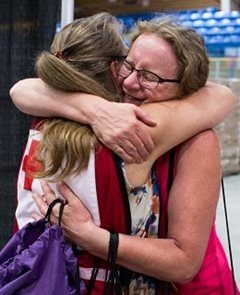
This decade brought with it a seemingly endless string of major disasters with widespread impact and devastation. In the face of these disasters, the Canadian Red Cross addressed new challenges at every turn, both at home and around the world.
During these years, the world saw a new wave of global migration – one unseen in history. With so many vulnerable people seeking safer and better prospects, the international community faced some of the most significant humanitarian challenges of the modern era.
There were two main causes of this surge in migration: prolonged conflict and political strife, and climate change and natural disasters. Some of the greatest devastation arose from the Syria Crisis and East Africa’s widespread drought and ensuing food crisis.
The Syria Crisis began in 2011 and by 2018 had resulted in more than a quarter million people killed and eight million displaced. The Canadian Red Cross supported urgent and ongoing medical needs inside Syria, as well as providing support to Syrian refugees who fled to neighbouring countries and Europe. Canada also opened its doors to 25,000 Syrian refugees between 2015 and 2016. The Red Cross joined a wide variety of individuals and organizations in welcoming them.
While on the west coast of Africa between 2014 and 2016, the largest ever Ebola outbreak struck Guinea, Sierra Leone and Liberia. The Canadian Red Cross sent 56 aid workers to help monitor, support, and provide education on the disease and prevention tactics. The Canadian Red Cross also provided material resources to establish an Ebola Treatment Centre in Sierra Leone. Though the outbreak was ultimately contained, fear of a global epidemic spread through Europe, North America, and Asia.
In East Africa, many were forced from their homes, not only as a result of political conflicts, but from multiple droughts that lead to a widespread food crisis across the region. In 2017, the Canadian Red Cross helped respond to a cholera epidemic in the region by setting up a treatment centre to help contain and treat this aggressive infectious disease.
While millions were forced on a path of migration, a number of catastrophic natural disasters caused suffering for millions more. The 2010 earthquake in Haiti flattened Port-au-Prince and devastated surrounding communities, leaving 200,000 people homeless while a 9.0 magnitude quake off the coast of Japan triggered a devastating tsunami.
In April 2015, a massive earthquake struck a highly populated area of Nepal in Kathmandu and the surrounding regions, and the country was hit by a second destructive earthquake the following month. Nine thousand lives were lost and 700,000 families were displaced. The Canadian Red Cross set up an emergency field hospital within days of the first quake, providing treatment to 5,400 patients over three months. In the Philippines, the 2013 Typhoon Haiyan was one of the strongest typhoons ever to make landfall. In the summer of 2017, a series of intense hurricanes hit the southeast U.S. and the Caribbean, including Hurricane Harvey and Hurricane Irma.
Meanwhile back in Canada, many of the worst calamities of the decade were climate related. Wildfires raged in Alberta, Saskatchewan, and B.C. in 2011, 2015, 2016 and 2017, devastating communities and displacing thousands of people. Alberta also experienced severe flooding throughout Calgary, High River and the surrounding communities in 2013. Ice storms in Ontario, Quebec and New Brunswick left many without power for days in the dead of winter. Indigenous communities faced emergencies on multiple fronts, particularly the housing crisis in Attawapiskat, the wildfires in Northern Manitoba, and the flooding and evacuation of Kashechewan.
Quebec witnessed some devastating tragedies, including a fire in the small community of L’Isle-Verte where 32 people lost their lives. In July 2013, when a train derailed and crashed through the town of Lac-Mégantic, killing 47 people, the Red Cross raised $14.8-million dollars to support this tight-knit community’s recovery.
In 2014, the Red Cross mourned the loss of Eva Pindoff, a compassionate humanitarian and long-time supporter. Mrs. Pindoff donated more than $20-million to support the Red Cross’s work and left a legacy of caring and compassion that continues to inspire a new generation of Canadian women to become philanthropic leaders. In 2011, the Red Cross launched Tiffany Circle, a group of women leaders who support the work of the Red Cross.
2016 was a milestone year for the Canadian Red Cross, marking its 120th anniversary. The Red Cross’s humanitarian work would not be possible without the aid workers whose medical, technical and psychosocial expertise helps to support people impacted by crises around the world.
One of the most effective ways to keep our citizens safe will always be to empower people with knowledge of first aid, safety and prevention. With that in mind, the Red Cross revamped its First Aid courses in 2016 to not only teach hands-on skills but to also instill the confidence that’s required to act in a emergency. In an effort to better understand water-related deaths, the Red Cross compiled a report in 2016 examining all drownings in Canada from 1991 to 2013. Also, smartphone apps became a great tool for promoting health and safety – the Red Cross developed two apps to help Canadians be prepared during an emergency by sending first aid and safety tips straight to people’s phones.
In this decade, there became more of a widespread mandate to promote mental health, and so the Red Cross launched its first ever mental health and first aid program. Fostering a culture of good mental health also meant raising happy and healthy youths, which is what started the anti-bullying movement and corresponding events like Red Cross Pink Day.
Sources:
CRCS. Annual Reports. 2010-2017.
redcross.ca